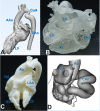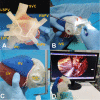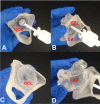Three-dimensional printing for heart diseases: clinical application review
- PMID: 33948306
- PMCID: PMC8085656
- DOI: 10.1007/s42242-021-00125-8
Three-dimensional printing for heart diseases: clinical application review
Abstract
Heart diseases remain the top threat to human health, and the treatment of heart diseases changes with each passing day. Convincing evidence shows that three-dimensional (3D) printing allows for a more precise understanding of the complex anatomy associated with various heart diseases. In addition, 3D-printed models of cardiac diseases may serve as effective educational tools and for hands-on simulation of surgical interventions. We introduce examples of the clinical applications of different types of 3D printing based on specific cases and clinical application scenarios of 3D printing in treating heart diseases. We also discuss the limitations and clinically unmet needs of 3D printing in this context.
Keywords: Cardiac imaging techniques; Congenital heart disease; Heart diseases; Three-dimensional printing; Transcatheter aortic valve replacement.
© The Author(s) 2021.
Conflict of interest statement
Conflict of interestThe authors declare that they have no conflict of interest.
Figures









Similar articles
-
Structural and congenital heart disease interventions: the role of three-dimensional printing.Neth Heart J. 2017 Feb;25(2):65-75. doi: 10.1007/s12471-016-0942-3. Neth Heart J. 2017. PMID: 28083857 Free PMC article. Review.
-
3D printing based on cardiac CT assists anatomic visualization prior to transcatheter aortic valve replacement.J Cardiovasc Comput Tomogr. 2016 Jan-Feb;10(1):28-36. doi: 10.1016/j.jcct.2015.12.004. Epub 2015 Dec 12. J Cardiovasc Comput Tomogr. 2016. PMID: 26732862 Free PMC article. Clinical Trial.
-
3D Printing Applications for Transcatheter Aortic Valve Replacement.Curr Cardiol Rep. 2020 Feb 17;22(4):23. doi: 10.1007/s11886-020-1276-8. Curr Cardiol Rep. 2020. PMID: 32067112 Review.
-
Three-dimensional printing in adult cardiovascular medicine for surgical and transcatheter procedural planning, teaching and technological innovation.Interact Cardiovasc Thorac Surg. 2020 Feb 1;30(2):203-214. doi: 10.1093/icvts/ivz250. Interact Cardiovasc Thorac Surg. 2020. PMID: 31633170 Review.
-
Assessment of Coronary Artery Obstruction Risk During Transcatheter Aortic Valve Replacement Utilising 3D-Printing.Heart Lung Circ. 2022 Aug;31(8):1134-1143. doi: 10.1016/j.hlc.2022.01.007. Epub 2022 Mar 30. Heart Lung Circ. 2022. PMID: 35365428
Cited by
-
Feasibility of 3-dimensional printed models in simulated training and teaching of transcatheter aortic valve replacement.Open Med (Wars). 2024 Feb 28;19(1):20240909. doi: 10.1515/med-2024-0909. eCollection 2024. Open Med (Wars). 2024. PMID: 38463517 Free PMC article.
-
Three-dimensional printed models as an effective tool for the management of complex congenital heart disease.Front Bioeng Biotechnol. 2024 Aug 2;12:1369514. doi: 10.3389/fbioe.2024.1369514. eCollection 2024. Front Bioeng Biotechnol. 2024. PMID: 39157439 Free PMC article.
-
Mitral Valve-in-Valve Implant of a Balloon-Expandable Valve Guided by 3-Dimensional Printing.Front Cardiovasc Med. 2022 May 30;9:894160. doi: 10.3389/fcvm.2022.894160. eCollection 2022. Front Cardiovasc Med. 2022. PMID: 35711355 Free PMC article.
-
Balancing the customization and standardization: exploration and layout surrounding the regulation of the growing field of 3D-printed medical devices in China.Biodes Manuf. 2022;5(3):580-606. doi: 10.1007/s42242-022-00187-2. Epub 2022 Feb 15. Biodes Manuf. 2022. PMID: 35194519 Free PMC article. Review.
-
Transapical Transcatheter Aortic Valve Replacement Under 3-Dimensional Guidance to Treat Pure Aortic Regurgitation in Patients with a Large Aortic Annulus.Rev Cardiovasc Med. 2024 Sep 9;25(9):319. doi: 10.31083/j.rcm2509319. eCollection 2024 Sep. Rev Cardiovasc Med. 2024. PMID: 39355610 Free PMC article.
References
-
- Baumgartner H, Falk V, Bax JJ, De Bonis M, Hamm C, Holm PJ, Iung B, Lancellotti P, Lansac E, Munoz DR, Rosenhek R, Sjogren J, Tornos Mas P, Vahanian A, Walther T, Wendler O, Windecker S, Zamorano JL, Group ESCSD 2017 ESC/EACTS Guidelines for the management of valvular heart disease. Eur Heart J. 2017;38:2739–2791. doi: 10.1093/eurheartj/ehx391. - DOI - PubMed
Publication types
LinkOut - more resources
Full Text Sources
Other Literature Sources
